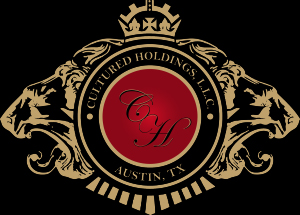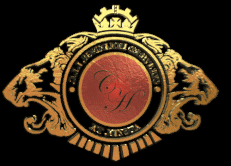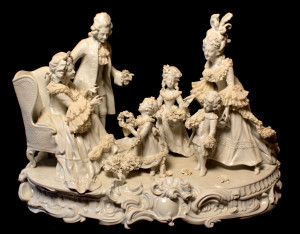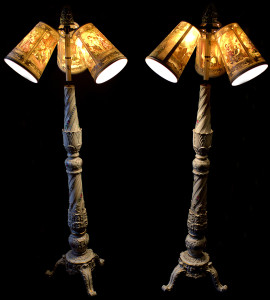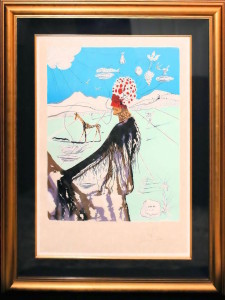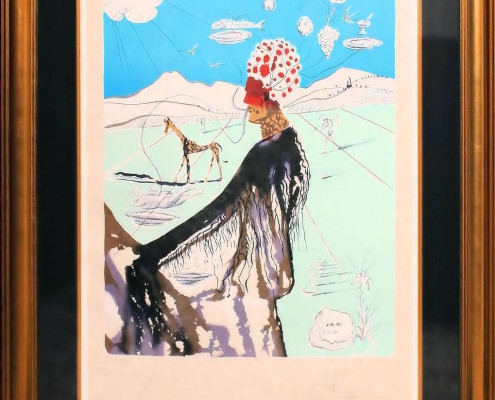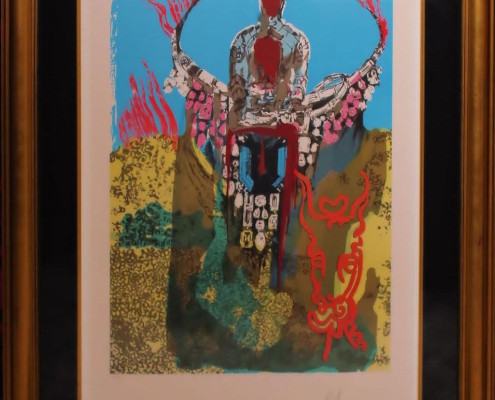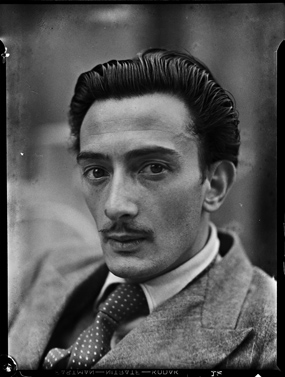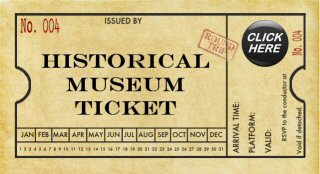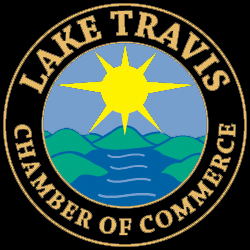Paintings & Wall-hangings
All current pieces in our Salvador Dali collection are 100% guaranteed authentic and are accompanied by appraiser Peter B. Lucas’ COA. Mr. Lucas not only worked with Master Dali in conceiving the initial seeds from which sprung such monumental works as Changes in Great Masterpieces and more prominently “Persistence of Memory” from the series, but is also considered in some quarters as the foremost North American publisher of original Dali lithographics. Learn more about Salvador Dali or Peter B. Lucas at the bottom of this page.
The Chef: King of the Land and Sea
Artwork: “THE CHEF: KING OF THE LAND AND SEA”
Medium: Hand-signed lithograph from an original gouache painting by Spanish Surrealist Salvador Dali.
Era: Published in 1980 by Levine & Levine in a total edition of 1195.
Mark: #I 29 of 150 on Japon Paper; It bears a blind stamp in the lower left hand corner that reads “Dalart N.V./Copyright 1980″.
Condition: Excellent; Framed; COA
Artist: Salvador Dali (1904-1989)
Dimensions: 38″H x 30″W (with frame)
Price: $5,000
The Bullfighter
Artwork: “THE BULLFIGHTER”
Medium: Hand-signed lithograph with an original lithograph Remarque by Spanish Surrealist Salvador Dali.
Era: Published in 1980 by Levine & Levine in a total edition of 1195.
Mark: #10 of 250 on Arches Paper
Condition: Excellent; Framed; COA
Artist: Salvador Dali (1904-1989)
Dimensions: 38″H x 30″W (with frame)
Price: $3,500
Salvador Dali
The Spanish artist, Salvador Dali, is considered one of the most impressive artists of the 20th century, not only because of his paintings but also because of his eccentric character. Dali was born in 1904 in Figures, Spain, nine months after the death of his older brother, who was also named Salvador. At the young age of ten, Dali first began painting. It was at the age of 12 the he vacationed with an artistic family, the Pichots. Ramon Pichots was probably Dali’s first role model as a painter and influenced much of his early development and interest in art. He later attended Municipal Drawing School, where he first received formal art training, learning draftsmanship, painting, and engraving from Senor Nunez. In 1917, Dali’s father organized an exhibition of his charcoal drawings in their family home. A year later, in 1918, one of his drawings was published in a Catalan magazine, Patufet. Dali was also recognized in local newspapers and the magazine Stadium. In 1921, Dali’s mother passed away. Quickly after her death, his father married her sister.
Having been already exposed to the artist movement and style of Impressionism, Post-Impressionism and Futurism, he was accepted to the Academia de San Fernando in Madrid, only to be expelled in 1926 for refusing to take the examination in “Fine Art Theory”. He stated that the faculty was not competent enough to examine him. During this time, he explored cubism, Neo-Classicism, and realism in his paintings. The year 1929 proved to be an important year for Dali: He made his first Surrealist film, Un Chien Andalou (An Adualusian Dog) with former classmate Luis Bunuel, joined the Surrealist group, and in June, he met Gala Eluard, the wife of Paul Eluard, a Surrealist poet. She eventually became his wife, his muse, and influence behind many of his paintings. Other inspirational people for Dali were Picasso, Miro, the architect Gaudi, and especially the landscape of Catalonia.
The surrealist ideology was based on Freudian psychology, which systematized the analysis of dreams as revealed in images from the subconscious. Many of Dali’s work during the 1930’s were intaglio prints that accompanied Surrealist books and periodicals, these prints included “L’ Immaculee Conception” and “La Femme Visible”.
The works leaned towards provocative, and the “paranoiac-critical method,” which Dali defined as a spontaneous mode of irrational understanding based on interpretative critical association on delirious phenomena. The Oxford Companion to Art refers to it as “an attempt to make systematic use of the organizational for of hallucinatory and obsessive experience with special emphasis on multiple figurations.” These works were though of as risqué and controversial, even by the Surrealist group. Eventually, in 1934 Dali separated from the Surrealist group, because of his conflicting view towards their commitment to Marxist politics and development of rituals. He demanded absolute freedom, and he felt their censorship and political motivations were constructing his ingenuity.
Dali and Gala fled the German invasion of France in 1940 and headed towards the United States, where they stayed until 1948. During much of this time Dali gained international fame be capitalizing on self-advertising through television, advertisements, and publications. As one of the most diverse artists of the twentieth century, Dali worked in many mediums, designing stage settings, jewelry, clothing, and perfume; he also worked on animation for Walt Disney movies, which were never finished. He refers to this period as the time he desired to become “classic”.
The bombing of Nagasaki and Hiroshima made quite an impression on Dali, he entered what is called his Nuclear and Atomic period. By the 1950’s he had begun to focus on religious themes and in the 1960’s Dali experimented with Pop and Op Art, as well as Abstract Expressionism which eventually culminated in the stereoscopic paintings and holographs of the 1970’s. In the early 1950’s he developed his principals of Nuclear Mysticism, in which he concluded the “the very basis of life would prove to be spiral.”
In 1970, Dali and Gala parted ways and he gave her the Castle at Pubol and only visited her with written invitation. In 1982, Gala died at the Castle Pubol. With his muse gone, he no longer had the desire to create and only did a handful of paintings and prints. Before dying of heart failure in 1989, he lived in his museum, surrounded by his art, which was his life.
